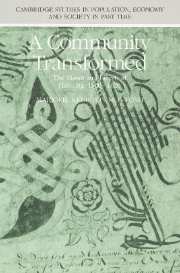Book contents
- Frontmatter
- Contents
- List of figures
- List of tables
- Acknowledgements
- Abbreviations
- Introduction
- 1 Life and death
- 2 Changing economic patterns
- 3 Religion
- 4 Facets of a society in transition
- 5 Havering's declining independence
- 6 Overt conflict, 1607–19
- Conclusion
- Appendices
- Bibliography
- Index
- Cambridge Studies in Population, Economy and Society in Past Time
5 - Havering's declining independence
Published online by Cambridge University Press: 11 October 2009
- Frontmatter
- Contents
- List of figures
- List of tables
- Acknowledgements
- Abbreviations
- Introduction
- 1 Life and death
- 2 Changing economic patterns
- 3 Religion
- 4 Facets of a society in transition
- 5 Havering's declining independence
- 6 Overt conflict, 1607–19
- Conclusion
- Appendices
- Bibliography
- Index
- Cambridge Studies in Population, Economy and Society in Past Time
Summary
Compared to most communities in England, Havering had an unusual degree of local autonomy even in 1620. Its manor court met at least six times per year, dealing with land transfers, private suits between the residents, and certain kinds of public business. The Liberty of Havering-atte-Bower had its own Justices of the Peace, one of them elected by the tenants, who were empowered by law to perform all the functions of any county commission of the peace. The Liberty's coroner and clerk of the market likewise acted as the counterparts of their fellows at the county or borough level. Yet this local authority was but a shadow of the powerful and active institutions of the later fifteenth century, after the granting of Havering's Liberty charter in 1465. Then the community's leaders had used the power of their manor court and Liberty to the full, implementing justice and working to achieve an orderly environment conducive to good business and amicable social relations. A broad array of men from the crafts and trading world had joined their peers from the middling levels of the agricultural sector as participants in local government.
By 1620, most of Havering's legal and administrative rights had been taken over by outside bodies. The central courts heard private suits from Havering, while control over crime and appropriate social conduct was now handled largely by Essex JPs, the assize justices, and the church courts. This transition occurred with no objection from local people, who seem in most cases to have welcomed the more effective and neutral authority of extra-Havering institutions.
- Type
- Chapter
- Information
- A Community TransformedThe Manor and Liberty of Havering-atte-Bower 1500–1620, pp. 297 - 363Publisher: Cambridge University PressPrint publication year: 1991

